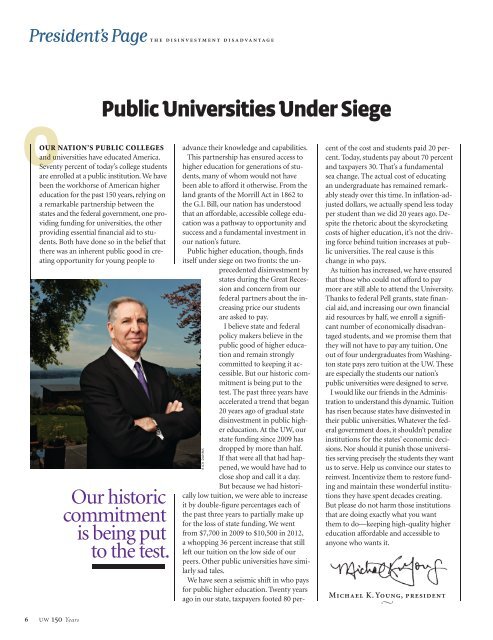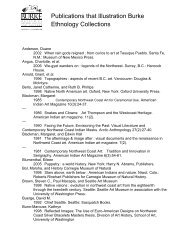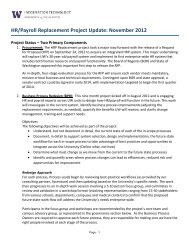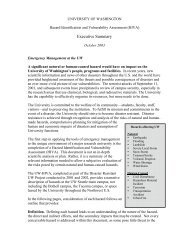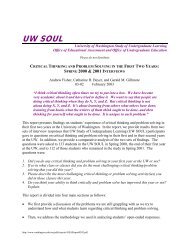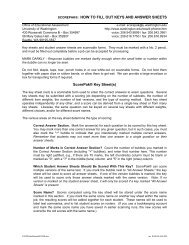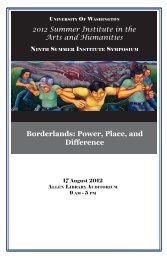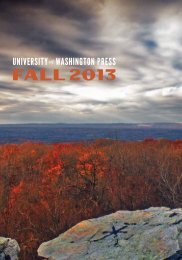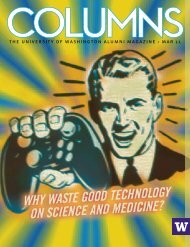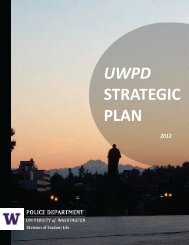PDF version - University of Washington
PDF version - University of Washington
PDF version - University of Washington
Create successful ePaper yourself
Turn your PDF publications into a flip-book with our unique Google optimized e-Paper software.
President’s Page the disinvestment disadvantage<br />
OOUR NATION’S PUBLIC COLLEGES<br />
and universities have educated America.<br />
Seventy percent <strong>of</strong> today’s college students<br />
are enrolled at a public institution. We have<br />
been the workhorse <strong>of</strong> American higher<br />
education for the past 150 years, relying on<br />
a remarkable partnership between the<br />
states and the federal government, one providing<br />
funding for universities, the other<br />
providing essential financial aid to students.<br />
Both have done so in the belief that<br />
there was an inherent public good in creating<br />
opportunity for young people to<br />
6 UW 150 Years<br />
Public Universities Under Siege<br />
Our historic<br />
commitment<br />
is being put<br />
to the test.<br />
RICK DAHMS<br />
advance their knowledge and capabilities.<br />
This partnership has ensured access to<br />
higher education for generations <strong>of</strong> students,<br />
many <strong>of</strong> whom would not have<br />
been able to afford it otherwise. From the<br />
land grants <strong>of</strong> the Morrill Act in 1862 to<br />
the G.I. Bill, our nation has understood<br />
that an affordable, accessible college education<br />
was a pathway to opportunity and<br />
success and a fundamental investment in<br />
our nation’s future.<br />
Public higher education, though, finds<br />
itself under siege on two fronts: the unprecedented<br />
disinvestment by<br />
states during the Great Recession<br />
and concern from our<br />
federal partners about the increasing<br />
price our students<br />
are asked to pay.<br />
I believe state and federal<br />
policy makers believe in the<br />
public good <strong>of</strong> higher education<br />
and remain strongly<br />
committed to keeping it accessible.<br />
But our historic commitment<br />
is being put to the<br />
test. The past three years have<br />
accelerated a trend that began<br />
20 years ago <strong>of</strong> gradual state<br />
disinvestment in public higher<br />
education. At the UW, our<br />
state funding since 2009 has<br />
dropped by more than half.<br />
If that were all that had happened,<br />
we would have had to<br />
close shop and call it a day.<br />
But because we had historically<br />
low tuition, we were able to increase<br />
it by double-figure percentages each <strong>of</strong><br />
the past three years to partially make up<br />
for the loss <strong>of</strong> state funding. We went<br />
from $7,700 in 2009 to $10,500 in 2012,<br />
a whopping 36 percent increase that still<br />
left our tuition on the low side <strong>of</strong> our<br />
peers. Other public universities have similarly<br />
sad tales.<br />
We have seen a seismic shift in who pays<br />
for public higher education. Twenty years<br />
ago in our state, taxpayers footed 80 percent<br />
<strong>of</strong> the cost and students paid 20 percent.<br />
Today, students pay about 70 percent<br />
and taxpayers 30. That’s a fundamental<br />
sea change. The actual cost <strong>of</strong> educating<br />
an undergraduate has remained remarkably<br />
steady over this time. In inflation-adjusted<br />
dollars, we actually spend less today<br />
per student than we did 20 years ago. Despite<br />
the rhetoric about the skyrocketing<br />
costs <strong>of</strong> higher education, it’s not the driving<br />
force behind tuition increases at public<br />
universities. The real cause is this<br />
change in who pays.<br />
As tuition has increased, we have ensured<br />
that those who could not afford to pay<br />
more are still able to attend the <strong>University</strong>.<br />
Thanks to federal Pell grants, state financial<br />
aid, and increasing our own financial<br />
aid resources by half, we enroll a significant<br />
number <strong>of</strong> economically disadvantaged<br />
students, and we promise them that<br />
they will not have to pay any tuition. One<br />
out <strong>of</strong> four undergraduates from <strong>Washington</strong><br />
state pays zero tuition at the UW. These<br />
are especially the students our nation’s<br />
public universities were designed to serve.<br />
I would like our friends in the Administration<br />
to understand this dynamic. Tuition<br />
has risen because states have disinvested in<br />
their public universities. Whatever the federal<br />
government does, it shouldn’t penalize<br />
institutions for the states’ economic decisions.<br />
Nor should it punish those universities<br />
serving precisely the students they want<br />
us to serve. Help us convince our states to<br />
reinvest. Incentivize them to restore funding<br />
and maintain these wonderful institutions<br />
they have spent decades creating.<br />
But please do not harm those institutions<br />
that are doing exactly what you want<br />
them to do—keeping high-quality higher<br />
education affordable and accessible to<br />
anyone who wants it.<br />
Michael K. Young, president


